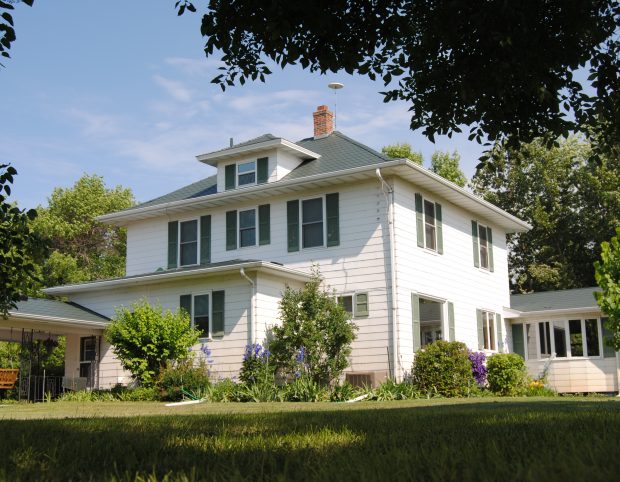Marketed as a long-lasting, low-maintenance product, fiber cement siding is often compared favorably to wood or vinyl siding. However, many homeowners are surprised to learn that this type of siding has some significant drawbacks, ranging from maintenance issues to health concerns. Before you invest in fiber cement siding, it’s worth taking a closer look at the potential downsides and exploring better alternatives, such as seamless steel.
What Is Fiber Cement Siding?
Fiber cement siding is made from a mixture of cement, sand, and cellulose fibers. It’s designed to mimic the appearance of wood while resisting fire, pests, and rot. In the US, this type of siding is also called “Hardie Siding” or Hardie Plank,” after the manufacturer James Hardie. Hardie siding remains a popular choice for fiber cement siding, but it is not without issues (more on that in a bit).
Why Do People Use Fiber Cement Siding?
Homeowners often choose fiber cement siding because it is resistant to flames, won’t warp like vinyl, and can hold paint well. For those wanting a traditional wood look without the same risk of rot or termites, fiber cement siding can seem like an attractive option, at least on the surface.
Known Problems With Fiber Cement Siding
Health Risks
Older versions of fiber cement siding contained asbestos, which poses a serious health risk during removal or renovation. While modern siding no longer contains asbestos, it still releases crystalline silica dust when cut or sanded. Inhalation of silica dust is a known cause of silicosis, a potentially fatal lung disease. While this is primarily a concern during installation, boards can break down over time, raising questions about long-term exposure.
Misleading Lifespan Claims
Hardie fiber cement siding was once marketed to last 50 years, but many homeowners began reporting problems within 10–15 years. A class action lawsuit was even filed alleging premature failure, cracking, and warping well before the advertised lifespan.
Moisture Absorption
If not installed correctly, the fiber cement siding can absorb water. In areas with heavy rainfall or snow, trapped moisture can cause mold growth, rot, panel damage, swelling, cracking, and structural damage. Nebraska’s freeze-thaw cycles can make this problem even worse.
Constant Maintenance
Though not as high maintenance as wood, fiber cement siding does require fairly regular repainting, caulking, and inspections to keep it in good shape. Without diligent upkeep, moisture damage, chipping, and fading are more likely to occur.
Pest Prone
While fiber cement isn’t a food source for pests, insects like wasps and carpenter bees can still nest in gaps or cracks. Rodents can also chew through weakened boards to access your home.
Not Eco-friendly
Cement production is one of the largest contributors to global carbon emissions, and fiber cement siding isn’t recyclable like steel. This makes it a less sustainable choice for environmentally conscious homeowners.
Why Choose Steel Siding Over Fiber Cement Siding
When comparing exterior siding options for Nebraska homes, steel siding consistently outperforms fiber cement in durability, maintenance, weather resistance, and sustainability. Here’s why seamless steel siding is often the smarter investment:
Superior Durability
Nebraska’s climate is tough on exterior materials. High winds, hail, and heavy snow can take a toll. While fiber cement siding can crack, chip, or absorb moisture over time, steel siding is virtually impervious to these threats. It won’t warp, swell, or split, even during extreme freeze-thaw cycles.
True Low Maintenance
Fiber cement siding requires repainting at least every 20 years, regular caulking, and inspections. On the other hand, steel siding is coated with durable finishes that resist fading, chalking, and peeling for decades. No scraping, sanding, or repainting is needed, just the occasional rinse with a garden hose.
100% Moisture and Pest Proof
Fiber cement siding can absorb water, especially if the paint or caulk wears down or it isn’t installed correctly. Steel siding is completely nonporous, meaning water can’t seep in. It also offers zero appeal to pests, rodents, and termites. Another plus is that carpenter bees can’t chew, burrow, or nest in it, either.
Eco-Friendly and Fully Recyclable
Unlike fiber cement, which ends up in a landfill at the end of its life, steel siding is recyclable and often made from recycled steel in the first place. Steel manufacturing produces fewer greenhouse gas emissions than cement production, which makes it a greener choice for environmentally conscious homeowners.
Longer Lifespan Without the Fine Print
Fiber cement siding may advertise a 50-year lifespan, but many homeowners find it starts failing much sooner without meticulous upkeep. Steel siding can easily last 50 years or more without constant maintenance.
Seamless Installation for Superior Protection
At ABC of Nebraska, our galvanized seamless steel siding is custom-cut to the exact length of your home, eliminating vertical seams that can let in water or pests. The result is a sleek, polished look that’s functional and beautiful.
Seamless Steel Siding In Omaha, Lincoln, and Grand Island
At ABC of Nebraska, we specialize in seamless steel siding that looks beautiful and stands the test of time. If you’re ready to protect your home with a truly low-maintenance, eco-friendly solution, contact ABC Seamless of Nebraska today for a free estimate.




